Comprehensive Instruction in the Cornerstone Skills of Bushcraft
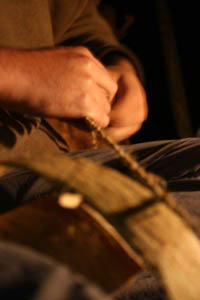
Would you like to gain a rounded set of outdoor skills that are widely-applicable wherever in the world you find yourself?
Do you want to make sure you receive expert instruction from high-calibre instructors?
In studying bushcraft, you study nature.
As you learn the various ways to use natural resources, you begin to see a world populated by familiar and useful friends that can be called upon when needed.
A week-long course in the cornerstone skills and knowledge of bushcraft provides an immersion in learning and a breadth of experience not possible during a shorter course.
A week-long course – is there really that much to learn? It’s true there are many short bushcraft courses out there. They are popular and the best ones convey a good amount of knowledge in a short amount of time. But there is a limit to how much they can cover in only a day or two.
Once we move away from the very basic techniques, acquiring more advanced skills requires practice. This of course, requires more time.

While there are fewer providers of week-long courses than short courses, it’s not because there isn’t much more to learn.
Bushcraft Encompases an Extensive Body of Knowledge
In learning the techniques of bushcraft, you will certainly gain the ability to utilise natural resources to provide for your basic needs – fire, shelter, water and food.
Bushcraft, however, offers much more than basic survival skills.
Bushcraft is a massive grouping of skills and knowledge which encompasses botany, butchery, campcraft, cookery, craftwork skills, firecraft, fishing, mycology, navigation, outdoor safety, stalking, tracking, trapping, wood carving, zoology and much more.
Each of the above could easily warrant a course in its own right.
And that’s before we even begin to consider the journeying skills such as canoeing, kayaking, hiking, skiing, snow-shoeing, horse-riding, motor-bike riding or off-road driving, that might take us to wild or remote places.
Introducing the Elementary Wilderness Bushcraft Course
The week-long Elementary Wilderness Bushcraft course is an immersive, challenging yet enjoyable programme of learning in the woods that delivers a broad base of skills.
Learn a Syllabus Selected and Taught by Experts
We have created a well-chosen syllabus of the most widely-applicable techniques and in-depth knowledge.
Throughout you’ll be taught, helped and accompanied by Frontier Bushcraft’s experienced, skillful and friendly instructors.
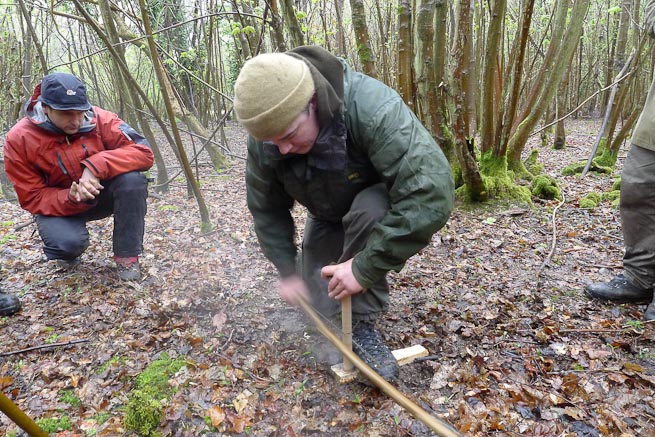
Make the Skills Your Own
During the course there is always practical application of the skills being taught. We also provide in-depth background information so that you have both the judgement and ability to apply the techniques in different situations.
The aim of this 1-week Bushcraft course is not for you to only see the techniques, or even just ‘have a go;’ rather, the aim is for you to make these important techniques your own. This will, by definition, require active effort on your part.
But you will be guided and encouraged every step of the way. To this end, the Elementary Wilderness Bushcraft course provides comprehensive instruction in the cornerstone skills of bushcraft with a high instructor-to-student ratio.
Our goal is for you to leave the course capable, enabled, with a good understanding of how to hone your skills and take them further.
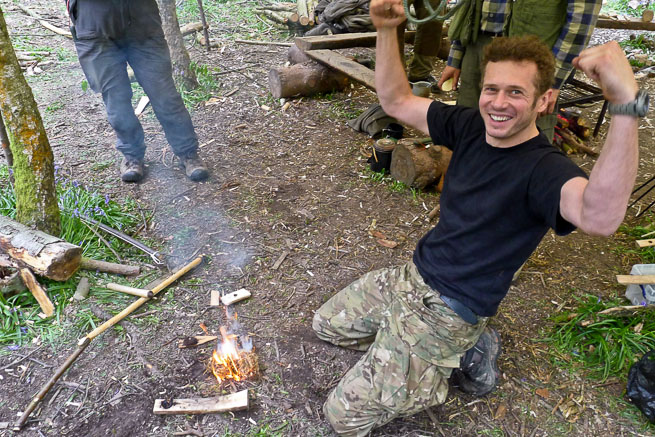
Tried and Tested Teaching Methodology
Throughout the course, key skills are introduced, thoroughly explained and demonstrated. You will then be given the opportunity to practice the skills under the watchful eyes of the instructors. These skills will be built upon throughout the week in layers and you will come back to core techniques repeatedly. Practice does indeed make perfect!
For most people the course is tiring but, as with many things in life, the benefits you get from bushcraft skills are in proportion to the effort you put into mastering them.
You’ll Gain More than Just a Set of Skills
Wilderness bushcraft not only increases your self-reliance in the great outdoors; your confidence grows and you become more relaxed.
This course provides a fantastic opportunity to gain a solid grounding in wilderness bushcraft and learn directly from expert instructors.
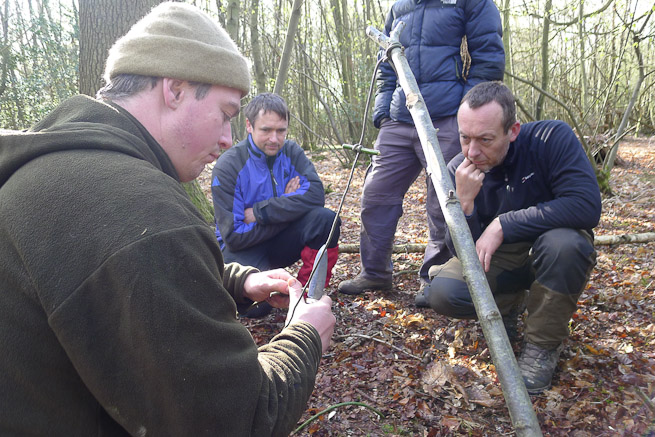
What’s In The Elementary Wilderness Bushcraft Course? What Skills Will it Give You?
Here’s an overview…
Water and Water Purification:
In different environments you need varying amounts of water to remain well-hydrated. In some environments water can be hard to find and you need to know where to look. Even when you do find water, more than two-thirds of the world’s fresh water is unsafe to drink. The course provides in-depth knowledge of what the problems are and how to avoid them, with failsafe protocols for water purification anywhere in the world. These will be applied on the course repeatedly so that you know them inside-out.
Shelter:
Being able to provide ourselves with shelter from the elements is essential in the great outdoors. From fast and efficient tarp pitching (and we mean really fast) to considerations for locating and building shelters from natural materials, the course covers all aspects of shelter-erection. In the past we’ve found that many people have difficulty remembering tarp knots. The course is structured so that you have multiple opportunities to apply all of these knots. By the end of the week, they will be ingrained.
Fire:
Harnessing fire is what differentiates us from other species. It allows us to subsist in regions where it would otherwise be too cold or too wet. Fire warms us, dries our clothes, cooks our food, makes our water safe to drink, illuminates our camp, discourages dangerous animals and biting insects, allows us to signal and provides the means to manipulate and shape natural materials. From basic survival through to more advanced bushcraft, being able to light and manage a fire is the most important wilderness skill.
Fire-Lighting:
Whatever level of fire-lighting skill you already have, this course is designed to refine and broaden your skills. You’ll master fire-lighting with sparks, matches and lighters, even in pouring rain. You’ll be amazed at the range of natural and man-made materials that can be ignited if prepared properly. We’ll show you all the ways in which you can create a flame. Top of most course attendees’ lists is the desire to light fire by friction – something that the majority of people find extremely difficult without being tutored. We provide comprehensive instruction in the bow-and-drill method on this course. This is the most widely-applicable of the friction fire-lighting methods. Our aim is for each individual on the course to achieve success with this method.
Fire-Management:
In addition to being able to reliably and consistently light a fire in all conditions, you also need to know how to select fuel and structure your fire to provide the outcome you require: Are you looking to boil a billy can quickly for a brew? Are you going to roast a meal over the fire? Are you building a fire for warmth during the night? Do you need illumination? Some woods burn quickly, others brightly. Some woods provide hot, long-lasting embers while others are toxic. Different fire-lays produce different effects. We cover what you need to know to get it right.
Natural Cordage:
Producing cordage from natural materials is a much under-valued skill. You need bindings for many purposes in the outdoors, from camp gadgets to bark containers to shelters. Without cordage you can’t make snares, fishing lines or nets. You need cordage for the bow-and-drill method of friction fire-lighting. More advanced traditional skills such as building canoes or toboggans also require natural bindings. We’ll show you how to select and process a wide range of natural materials for bindings and cordage.
Cutting Tools:
While many of the tasks of bushcraft are possible without a cutting tool, some are impractical and most are made easier if you have at least a knife. We cover tool selection, use and care, including practical advice on sharpening.
Carving Skills:
With access to metal tools that can attain and hold a good edge, the possibilities of what we can fashion from natural materials is extended considerably. The course covers the safe use of cutting tools then progresses through basic utility carving to shaping more elaborate but equally useful items. Even if you are used to using a knife, we’ll add insight or impetus to your carving.
Wilderness Fishing Techniques:
While modern angling for sport is a leisure activity enjoyed by many, it isn’t always the most efficient way of catching fish. We explain and show you the most effective active and passive fishing techniques that are easily applied with minimal equipment. This will increase your chances of getting fish out of the water if you need to. You’ll also learn how to gut and prepare fish of various sizes, including cooking them over a fire.
Traps and Trapping:
If we are to rely on nature for sustenance, then in addition to knowing where animals may be active, we also need to know how to catch them effectively. We cover legal (UK) methods of trapping and, if time allows, one or two traditional methods of trapping that should only be applied in a survival situation or in territories where they are legal. Studying traps is interesting even for those who have no interest in catching animals. Many of the trigger mechanisms are ingenious and they give an insight to the inventiveness of our forebears.
Small Game Preparation:
If we obtain small game, then we need to know how to prepare it. Many people these days have very little idea of how to butcher even a small animal, let alone a larger one. Even though larger animals can feed many people for days, you will most regularly be preparing small game. We show you quick and easy methods of making the most of the meat from a small mammal.
Plant and Tree ID:
At the heart of bushcraft is the study of nature. Central to this is knowledge of trees, plants and their uses. This starts with being able to reliably identify various useful species. Until you can recognise which bark to use for tinder or for cordage-making, for example, then you cannot proceed to the next stage of the process. We’ll show you how to reliably identify key species with a broad geographical distribution, so that you can always utilise the resources they provide.
Plants and Trees for Food and Medicine:
In addition to identifying key species for their utility, you should also know important species for food. Which species yield the most energy? Which contain a significant amount of protein or fat? Which are easy to collect? Which have a wide geographical distribution? How do you process them? Plants are also a source of medicine and we look at some of the more important ones. Importantly, when selecting plants for food or medicine, we need to ensure we select the correct species and do not confuse them with toxic species. We provide clear guidance on this important aspect of foraging.
Wilderness Outfit:
What kit do you really need? What are the most essential items to carry on your person? Which clothing works well and why? How do you pack it? All this and more will be discussed and explored during the course. Even the hardened kit fanatic will be discarding previously-essential items at the end of this week. One of the beauties of bushcraft is that it shows us how little of our equipment is of much importance as well as showing the great importance of a few key items.
Looking After the Land and Leave-no-Trace:
Throughout the course, there is an emphasis on using natural resources sparingly, taking only what you need. While many bushcraft skills have an impact on the local environment, we encourage thoughtfulness in harvesting materials. There are also some legal considerations, particularly with regards to foraging. One of the key skills of wilderness bushcraft is the harnessing of fire. But a fire managed badly can cause damage to an environment. We teach how to judge whether a fire is appropriate and, if so, how to manage it and clear-up appropriately.
Practical Bushcraft Skills for the Trail:
It’s one thing to practice various bushcraft techniques from the comfort of a base camp. It’s another to apply them in real-time while undertaking a journey. Our instructors are experienced wilderness travellers and will show you how to apply your skills in a realistic way.
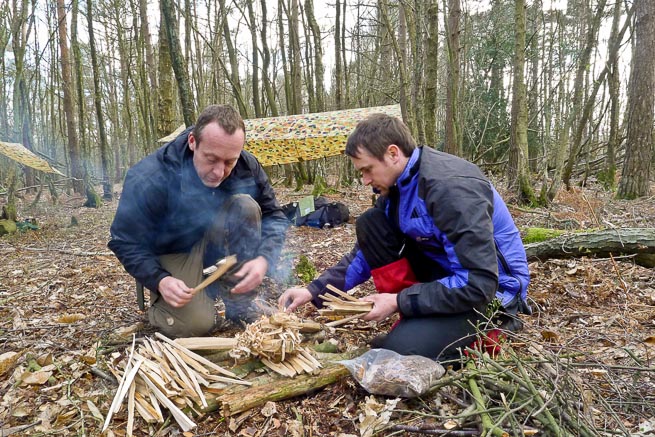
What People Say About The Elementary Wilderness Bushcraft Course:
“Meeting other like-minded people, developing the mental attitude to succeed and bringing a multitude of skills and knowledge together as a complete bushcraft package rather than several separate areas of interest – I should have done this ages ago and can’t wait to do another course.”
Stewart Lomax, Kent.
“Not having any clue what to expect or what would be expected of me I wondered if I would be able to cope. But what I found was I felt so alive and inspired during my seven days with you. You delivered so much more than I could ever have imagined. Your expertise and knowledge was immense; I did not have a minute to worry about life on the outside and that was truly fantastic- a breath if fresh air!! I feel that I am equipped to get out there and be a true wild camper. I also feel mentally stronger; I learnt quite a lot about myself. I felt totally confident with you and safe in your hands – this is huge for me! See you very soon, I will be doing all of your courses. I feel so excited to have found what makes me tick, no more bloody boring beach holidays for me again – it’s all about ADVENTURE!”
Henrietta Martin, East Sussex.
“This course was an amazing experience! The skills you will learn are breathtaking. Incredible value for money. Oh, and the food was superb; best I have ever experienced on an outdoors course. Sign up now!”
Ray Sterling, Cornwall.
“Many thanks for providing me with a very good course. My main concern when I booked was would it live up to what I thought it would and all I can say is yes and much much more. There is no substitute for good hands on experience. I could’ve carried on watching the YouTube videos and reading a lot of books – some good and some quite bad – but to have you teaching us the way you do with the patience and professionalism that you are all about, made my course all the better. I loved doing the course and learned a lot from it – from the large amount of kit I now know I don’t need to carry down to how to light a fire for cooking etc. I have experience in that type of thing but to be re-taught it again in a much more relaxed environment was a joy, although a little frustrating when I didn’t get it right the first time on my own. But that’s what the course was all about for me – hands on practice, and more practice. I would certainly recommend this course to anyone who is serious about getting the best bushcraft training and best hands on experience available. I will certainly be coming back for the Intermediate course in the future.”
John Baxter, Somerset.
“My main concern before attending this course was what to pack, even down to specifics of how many pairs of underwear/socks! I learned that all equipment is valuable but the right equipment in capable hands is essential. Learning new skills, like carving, cordage, fishing, fire making, rabbit preparation & plant identification, this course brought a wealth of basic knowledge that has opened my eyes to how much more knowledge I’m missing! There were also lots of firsts – My first night outside without a tent was a very liberating experience; First use of a bivvy bag; My fist night in a leaf shelter (in the rain); FINALLY getting an ember using a bow drill and making fire…but I think what I liked most has to be the intensity of the course, working from the moment you are out of bed to moment you return to it, having to become more efficient with more planning and kit awareness under strong guidance. It gave me the chance to see how I would perform under pressure, when tired, overflowing with information and in the rain (there is a test you know…). I think that to benefit from the course it is essential to have a reasonable amount of determination and willingness to learn and try things. Some of the people I know would shudder at the thought! Thanks again an hope to be on another course soon!”
John Keogh, Surrey.
“I would like to thank you again for the course, I very much enjoyed every part of it and found the experience both fascinating and humbling. It was great to be able to take the skills home to refine them, and once again, I am thoroughly looking forward to another of your courses.”
William Kelley, Surrey.
“I would recommend this course absolutely, for a whole multitude of reasons, but to pick a few: the mix of professionalism and joviality of the staff, the setting for the course, the fun & laughs that we all had, (when we weren’t busy cursing pieces of scorched wood), the sheer range of topics of skills and tips that were gained. In particuar, learning how to blow an ember into flame and several trouble-shooting pointers for how to create an ember via the bow drill method of friction fire lighting were the main things I gained from the course. This really is just the tip of the iceberg though. With hindsight, I think 2 things struck me: The first was the holistic nature of the course; the way each element fitted together with previous and later elements to form a whole experience. The second was the obvious depth and yet diversity of knowledge of the instructional team. Other benefits for me were witnessing the determination of individual instructors in completing a task and realising that this level of determination is easily transferable to many other scenarios in life. The importance of planning and preparation. Realising that there is so much more to this subject – stop making excuses, or putting it off, get out there and do it.”
Sean Redfern, New South Wales, Australia.
“You may watch videos or read books on bushcraft, but nothing beats the experience of doing it in real life. The course gives a good foundation to build your skills on. I came away with more knowledge than I could ever imagine getting. The instructors were excellent and gave so much to give you the best result in oneself. It’s a course that gets you to be more reliant on yourself and not your kit.”
David Atreides, London.
“Before this course I wondered if it will it be enough for me to build on. The answer is yes, because I seem to be gradually mastering the skills I was introduced to through practice. The main things I gained from this course were clear instruction that I have retained, and the confidence to build from there. The specific aspect that I liked the most, however, was the progressive nature of the skills taught, how one lead to the other, making it easier to assimilate and reproduce the methods acquired. For me, other benefits of attending this course were a sense of achievement (which is ongoing), confidence I can improve my bushcraft skills, and a healthy respect for the outdoors. I would recommend this course to anyone with an interest in the outdoors because I gained insights that will never leave me. The kind of knowledge this course imparts is assimilated very readily if the student is interested and I have found my outdoor experience to be much richer for it. “
Marco De Luca, London.
“The whole week spent with Frontier Bushcraft was a fantastic experience. It is hard to pin point any specific highlights as each day brought new challenges, knowledge and experiences. For me, the best points were the sheer amount of knowledge and expertise that was passed on by the instructors. This enabled me to sharpen my existing knowledge and learn many new skills. Waking up in the morning after a night spent under a tarp, watching the low morning sun shining through the trees and listening to the sounds of the woodland coming to life was also an unforgettable experience. Finally, the strong team spirit, the air of fun and laughter and the friendships which developed over the week, added to the sheer sense of achievement that this course gave is something that I shall take away with me and remember for the rest of my life.”
Duane Yates, Manchester.
“The week spent on the course was way more useful to me than I’d expected it to be and I had fairly high expectations after reading all the positive reviews on your site so thank you! The course gave me a more detailed knowledge of camp craft and “wild camping” as well as a reconfirmation of skills that I had acquired but not perfected. It was also good to highlight (to me) some of the areas that I’m not strong in (plant and tree ID) but by showing the practical use and requirement it gave me a drive to improve my knowledge in that area. In particular, I benefited from the course by 1/ getting a better understanding of the different ways of lighting a fire from natural resources; 2/ Working in and with a diverse group of people – you can’t always pick the people you’ll be with in every situation and this was a great demonstration of how you can work with other people and pool knowledge and experience to best effect; and 3/ Plant ID – much as this was by far my weakest point it’s the first time that I’ve looked at it as a really useful (even critical) skill for survival and general bushcraft. The knowledge held by the instructors and the way this was conveyed to the group (who had a variety of different knowledge levels) was spot on. No matter how early in the morning or late at night it was, Paul and Stuart were always ready to help out or impart knowledge. For me this was a step in a journey to being more adept at bushcraft and possibly being able to use this within my general life and career more in the future.”
Simon Slater, Hampshire.
“Before the course I had some concerns around the fact I’ve spent quite some time ‘living outdoors’ during my 16 years Army service, as well as a result of my Summer and Winter ML adventures. I was unsure as to whether the Elementary syllabus would be too ‘basic’ for me and subsequently may have been a waste of money and time. I expressed my doubts to Frontier Bushcraft via a voicemail and received a call back from Paul to discuss my concerns and questions. Following the discussion I followed Paul’s suggestions and registered for the Elementary course. Whilst there were some aspects of the syllabus that I had prior experience in, the vast majority of it was new territory for me so I appreciate the time and effort that Paul took to talk with me prior to booking – it was the right choice! My personal objectives for attending the course were: 1) To further my Tree and Plant Identification (further to the online Masterclass), 2) Develop an understanding and practical ability to achieve fire by friction, 3) Develop an understanding and practical ability to create natural cordage. I’m very pleased to say that I achieved all 3 objectives as well as a greater overarching appreciation of the value of ‘material selection’ as described in this video. Would I recommend this course? Absolutely! The combination of Paul and his team’s collective knowledge, experience and ability to convey information and skills in easily understood terms is a significant factor in the success of their courses. It is also worth highlighting the time and effort that Paul and his team put into making sure that each attendee reaches the peak of their potential during that week. There were several times during the week where I watched the Training Team work with students over and over and over and over again until the technique clicked.”
Craig Taylor, East Sussex.
“The main concern I had before the course was that my back would stop me from completing the week. With a little bit of self pushing and a positive mental attitude I found I flew through, so no worry there. I think the main things I gained from the course was the new knowledge I learnt, from bow drill to natural navigation, not forgetting the way to prep and make natural cordage. I loved all the course and all aspects of it. The great benefits of the course was having the watchful eye of experts watching and showing me where I need to improve. I’d definitely recommend the course to anyone that is serious about bushcraft as it has a straight forward, no b-s approach. All in all I had a great experience with the added bonus of coming away with new skills. Thanks guys.
Danny Barrett, Essex.
“Thanks for a really great week, I learned much more than I was expecting to. I’m finding that when I’m out and about I’m rather more observant now, trying to identify plants and working out what will make good kindling, or an addition to a salad…. I’ve also sourced some more material for another bow drill. I really liked the fire part of the course, in particular the proportion part and the foolproof way in which to get a fire going. I was particularly pleased with getting a fire going with nothing more than a spark, something I have failed to do previously. Also, plant identification, which I didn’t think I would particularly enjoy, but which turned out to be one of my favourite parts. Setting up a tarp correctly was beneficial as I’ve always tented before. I also liked the bushcraft navigation, even though it was only a small part. It demonstrated some clever ways of working out quite a bit of information knowing nothing more than some basic information about the Earth’s movement. Another benefit of this course for me was forward planning when out, working out what will make my life easier tomorrow. Finding tinder materials ahead of time, noting where good supplies of dead wood are, keeping fire wood dry under the tarps etc. I liked the fact that we were given quite a bit of responsibility for looking after ourselves, in the evenings in particular. There is nothing like knowing if you don’t get the fire started that dinner is going to be dry rice to motivate. However it did take me a night or so to cotton on to this fact and do things like stash firewood under my tarp, cut wood for the next night when I had time, pick up tinder as I saw it etc etc. I think this is partly because most courses, not necessarily bushcraft, I’ve been on have been rather more mollycoddling. I think my best evening was the night when it was hammering it down and the wind was blowing, but we were warm by the fire we’d managed to getting going under the big tarp, the trout cooking and sharing a pot of mint tea. That memory will stay with me for a while to come. I would recommend this course because you learn a hell of a lot and have an experience that is far from everyday life. I would caveat that with telling would-be attenders that it is hard and real effort will be required (I think that’s a good thing).
Richard Popple, Sheffield.
“I’ve wanted to do the course, just for the experience of it, for a while. I climb, and love the outdoors. This was a chance to add tools into my tool chest. I was also very attracted by the plant and tree ID element and the no nonsense, factual, base to the course. What I gained from the course can be summed up in the following point. On day one walking to the 1st camp I was slightly concerned and not at ease with the environment. That typical instinctual disquiet caused by dark woods. On the final morning I walked out of the camp to the parachute – completely at ease, and comfortable with the environment. The hands on aspect of this course was something I particularly liked – just enough pressure that things had to be done. I very much enjoyed the foody and forgaging sides and specific material identification and their use. During the course there was excellent use of camps to encourage immersion and removal of the comfort blanket of tents etc., This was a significant element for some people. I would recommend this course for the sense of accomplishment, hands on, excellent factual information, and committed instructors. An excellent base from which to build. Please don’t water down the physical aspect of the course … being tired and “claw handed” adds to the reality of the experience. As I finished the course I was physically tired, but the easier final day and the relaxed atmosphere of the tests helped to recuperate before the journey home. A couple of days post the course I have a definite sense of accomplishment. Type 2 fun if often the best fun and always comes with fonder memories. (Paul will understand the comment)! I look forward to the follow-up intermediate course next year.”
Simon Oliver, Cambridge.
Detail of What You Will Learn: The Syllabus
- How to choose cutting tools for wilderness bushcraft
- Safety in the use of cutting tools
- The knife techniques of bushcraft
- Carving skills and making useful utensils and gadgets
- Knife sharpening – at home and on the trail
- Methods of fire-lighting, including friction fire-lighting
- Choosing and preparing tinder and kindling
- Fire management and creating the right fire for the job
- Cooking with fires – with and without a cooking pot
- Water – finding, collecting and purifying
- How to choose and use a tarp
- Shelters from natural materials
- Making cordage from plant fibres, roots and bark
- Trees and plants for food and medicine
- Poisonous trees and plants
- Traps and trapping
- Small game preparation
- Wilderness fishing techniques
- Elementary natural navigation
- Wilderness environmental hazards
- Looking after the land and leaving no trace
All the Other Details You Need to Know…
Equipment
You don’t need to spend lots of money on specialist clothing or equipment for this course. What you will need is some basic outdoor clothing and camping equipment.
A full kit-list is available here and it will also be e-mailed to you with your e-mail receipt after your booking has been accepted.
Specialist equipment will be provided for your use during the course. This includes the loan of a tarp, bivvy bag, billy can, water purification kit, sharpening stone, folding saw, flint and steel as well as all group kit.
Accommodation
This course will be conducted entirely outdoors, from an expedition-style base camp and you will be camping out for the duration of the course.
There will be a covered teaching area which also serves as a communal area for breaks. There is a fire, kettle, tea, coffee, biscuits and cordial available here.
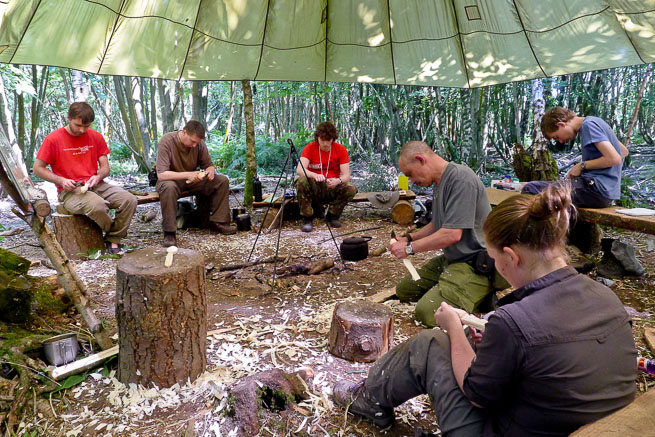
Food
All food is provided but a good amount of the preparation and cooking will be done by you and your fellow participants in order to provide you with practical experience of this aspect of outdoor living. Evening meal timings will be somewhat dependent on how quickly you gather firewood, organise yourselves and apply the fire-management skills being taught on the course. We will show you how to prepare a range of simple campfire meals and rest assured, you will not go hungry! To be clear, we do provide an evening meal on the first evening of the course.
If you have any allergies, food intolerances or other dietary requirements, please make sure you include this information when you book. There is an opportunity during the booking process to tell us about this.

Prerequisites and Experience Required
No previous bushcraft or camping experience is required to attend this course. All you need is a positive mental attitude, a willingness to learn and some perseverance to see tasks through. That said, you should note that this is not a nine-to-five course. The experience of living in the woods for a week is part of the learning process employed on the course, including preparing meals on a campfire and wild camping. The course programme is a full week of instruction and practical activities, with most people finding the course tiring. Indeed, it may at times stretch you. You will be living outdoors all week and you should be comfortable with the fact that you will be on your feet and/or using your hands for much of your waking hours.
FREE Equipment with this Bushcraft Course
During the course you will receive a Heavy Duty carbon steel bushcraft knife by Mora of Sweden, and a large Strikefire ferro rod – a British made product, using the best ferrocerium rod available
These are important pieces of kit and will be yours to keep.

Availability and Booking: Elementary Wilderness Bushcraft Course
Duration: 6 days.
Price: £747
Included: All instruction, food and specialist equipment. No hidden fees or extra kit rental.
Deposit: 25% on booking.
Suitability: 18 years and above.
Course size: 12 participants (maximum).
Course Meeting Time: 18:30 Day 1.
Course Finish Time: 16:00 Day 7.
Location: East Sussex.
Course Leader: A good number of our long-standing team members are qualified to run this cornerstone course. Any course leader will be accompanied by two or three course assistants too, ensuring a high staff-to-student ratio.
Elementary Wilderness Bushcraft Course Dates:
07/04/24 – 13/04/24
22/09/24 – 28/09/24
Back to the Frontier bushcraft courses page.

